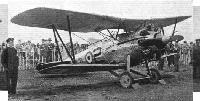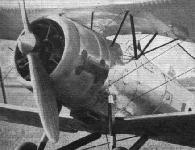
Flight, December 1930
THE BRISTOL "BULLPUP”
An Interceptor Fighter with Bristol "Mercury" Engine
DESIGNED to intercept an enemy raider as soon as possible after receipt of news that the raider is approaching a certain locality or area, two essential qualifications form the basis of the design of an aeroplane of this class: The greatest possible rate of climb, in order that the interceptor may reach the altitude of the raider in the shortest possible time, and high speed at the operational height of the raider, so that the interceptor may overtake the raiding aircraft without loss of time. In order to achieve these two essential qualities, the aircraft designed for interception of raiders must of necessity sacrifice certain other qualities. For example, the interceptor is assumed to be stationed at no very great distance from the route along which the raider is approaching, and, consequently it is permissible to reduce the range of the interceptor, or, in other words, to save weight by carrying a minimum of fuel. Also, as weight must be reduced in order to achieve the necessary climb, all items of equipment which it is at all possible to do without are omitted in this class of aircraft. For example, wireless adds a good many pounds of weight, and as the interceptor's duty is solely to find and attack the raider, and not to communicate his whereabouts to the ground or to other aircraft, interceptor fighters do not carry wireless. Briefly, the equipment of an interceptor fighter is reduced to the two bare necessities: Guns and oxygen apparatus (the class being intended to operate at great heights). This, at any rate, is the theory on which we are working at present, although it does not follow that the policy may not in time have to be changed.
The Bristol "Bullpup" is an interceptor fighter, generally similar in design and construction to the Bristol Company's well-known "Bulldog" ordinary fighter, but differing from the older machine in certain details, and carrying as equipment, guns, ammunition and oxygen apparatus only. The "Bullpup" carries two Vickers 0-303 guns, one on each side of the fuselage. The machine is of all-metal construction, with exception of the covering, which is fabric except for the forward portion of the fuselage. The pilot is situated behind the trailing edge of the top centre-section, which is cut away for view. The pilot's sight line is approximately parallel with, and some six inches below, the chord line of the top plane. The "Bullpup" has an overall length of 23 ft. 2 in. (7 m. 060), a wing span of 30 ft. (9 m. 150), and a height of 10 ft. (3 m. 050). A Very pistol is carried, with stowage space for cartridges. If desired, mountings can be supplied for extra guns on the lower wings. These gulls are operated by remote controls.
The Bristol Company has instituted a form of specification, couched in telegraphic terms, and with the items arranged in alphabetical order, which appears to describe the machine in the smallest possible space, and we have thought this style of description rather neat, and are retaining it in the following notes:-
Ailerons. - One pair on top wings only. Frise balance. Main spar and trailing edge in steel tube. Remainder in steel strip.
Aldis Ring and Bead Sights. - Mounted on a rigid tubular structure attached to the top of fuselage.
Belt Box. - Contains a total of 1,200 rounds. Easily filled and detachable. Constructed in duralumin with detachable necks and hinged doors for filling.
Rudder Bar. - Adjustable in flight through 4-in. horizontal movement. Adjustment does not necessitate altering length of control cables.
Elevator and Aileron Controls. - Operated by control column connected to a rockshaft on which a sprocket is mounted for operating the ailerons. The sprocket is connected by a chain to a secondary sprocket driving a lever. Thence by cables to pulleys near lower wing tip, then up to ailerons which are on top wing. Tecalemit lubricators fitted.
Centre Planes. - Steel tube spars and trailing edge. Duralumin sheet leading edge, and steel strip remainder. Top centre plane wire braced inside. Bottom centre plane strut braced to withstand undercarriage stresses.
C.C. Firing Gear. - Standard Air Ministry installation fitted.
Instrument Board. - Made in metal. A.S.I., altimeter and running switch fitted on port half. R.P.M., oil-pressure gauge, watch, doper and starting switch fitted on starboard side. Compass card holder, compass and cross level in centre.
External Bracing. – 3/8-in. single R.A.E. lift wires, 1/4-in. single R.A.E. ground wires (in each truss).
Single pair of N interplane struts.
Electrical Installation. - Generator, Mk. III.A. 500 watts at 12 volts (40 amps) fitted. Voltage control fitted (No. 2 Mk. III.A.). Generator field shunt fitted. Switchbox No. VII.A, fitted.
Fuselage Fore End. - High-tensile steel tube construction. Plate fittings at joints. No wire bracing in side elevation (tubes only).
Fuselage Rear End. - High-tensile strip steel construction. No wiring in sides, top or bottom plans. High-tensile steel tube stern frame braced in elevation with steel tube. Similar to fuselage front end in being exceptionally rigid.
Fin. - High-tensile steel tube framework with channel section duralumin ribs. Aluminium leading edge. Upper part forms a shield for balance of rudder.
Fireproof Bulkhead. – 1/8-in. asbestos with 26 SWG aluminium front and back.
Gun Mountings. - Steel box girder mounting Adjustment up and down, and sideways provided. Gun readily detachable from mounting.
Gas Starter System. - Installation provided for R.A.E. trolley gas starter, i.e., to plug in to side of fuselage, with distribution cock, master switch, &c, in the cockpit.
Wing Gun Mountings are optional. These are for mounting one (or more) pair of Lewis guns on the underside of bottom wings. Control - remote. Mountings adjustable to train the guns which are additional to Vickers.
Oleo Legs. - Oil and compression rubbers system. Rise about 4 in. on oil, and leaves about 1 1/8 in. for taxying on the rubbers. System same as Bulldog. Impossible to over fill with oil. Casing containing rubber is inside the fuselage fairing - giving minimum air resistance.
Oxygen System. - High-pressure type; 750-litre oxygen bottle. Mk. V, mounted in fuselage bay behind pilot's cockpit. Feeds to flowmeter Mk. 1.A, then on to delivery regulator, Mk. VII; thence to bayonet union Mk. II; thence to Mask Mk. II by flexible pipe.
Pilot's Seat. - Adjustable in flight. To suit seat type parachute. Adjustment 4 in. up and down by wheel screwing legs out of sockets.
Petrol Tanks. - One of 31 gallons in each top wing, 62 gallons in all. Filter and sight gauge fitted to each. Similar in type to Bulldog.
Petrol Gauge in Wing Tanks. - Similar to Bulldog, i.e., float, twisted spindle, magnetic coupling to coloured indicator visible through cellon window in base.
Petrol and Oil Systems. - Petrol system by gravity from wing tanks. No pumps, flowmeter, etc. Two control cocks only, one for each tank. Oil system standard, i.e., delivery by gravity from tank, return via oil cooler with safety valve to open when pressure rises beyond safety.
Tail Skid. - Telescopic compression rubber unit with swivelling shoe and radius rods to underside of fuselage. Tecalemit lubricators fitted.
Tail Actuating Gear. - Wheel in cockpit with tail setting indicator coupled to it. Screw jack at rear end, moving rear spar of tail vertically. Similar to Bulldog at rear end.
Undercarriage. - Similar to Bulldog, but is fitted with 650 x 125 Palmer wheels. Trulay cable bracing. Tecalemit lubricators fitted. Provision for undercarriage jack between axle and fuselage to enable a leg to be removed or for keeping. machine rigid when rigging.
Very Pistol, and stowage for six cartridges fitted.
Engine Mounting. - Solid forged steel ring engine mounting carried on and braced by high tensile steel tubes. Exceptional rigidity claimed.
Exhaust Ring. - Special ring forming part of cowling of N.A.C.A. type. Situated behind the cylinders.
Engine Cowling of N.A.C.A. type, completely enclosing engine. Formed of beaten aluminium panels between exhaust ring and back of propeller. Aluminium panels, detachable where necessary between exhaust ring and rear of pilot's cockpit, similar to Bulldog.
Oil Tank. - Gravity fed. Capacity 6 gallons. Incorporates special system to enable the oil to be warmed up rapidly for a quick departure without employing electrical heating of the oil. Tank mounted on top longeron, under fairing.
Oil Cooler. - New type of Bristol design, formed of 19 thin elliptical section tubes with short-circuiting pipe fitted with safety valves to prevent pressure bursting cooler when oil is thick.
Elevator. - Steel tube and strip construction, like tail plane.
- Flight, December 1930
THE BRISTOL "BULLPUP”
Фотографии
-
Flight 1930-11 / Flight
Регистрационный номер: J9051 [5] The Bristol Bullpup is an single-seater interceptor Fighter.
-
Flight 1930-12 / Flight
Регистрационный номер: J9051 [5] THE BRISTOL "BULLPUP": Three-quarter front view.
-
Flight 1930-12 / Flight
Регистрационный номер: J9051 [5] THE BRISTOL "BULLPUP": This side view shows the clean lines of the machine, and the neat cowling over the Bristol "Mercury" engine.
-
Flight 1935-07 / Flight
Регистрационный номер: J9051 [5] The Bristol "Aquila" engine was seen at Hendon for the first time in this Bristol "Bullpup."
-
Flight 1936-04 / Flight
Регистрационный номер: J9051 [5] Bullpup (sleeve-valve Aquila with combined long-chord cowling and Townend ring).
- Фотографии




